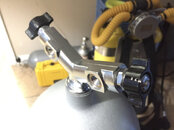Blackcrusader
Contributor
I don't believe you understand the "Last Stop" function. This does not set the depth your safety stop. OC Tec Mode does not have a safety stop feature. The "Last Stop" function sets the depth where you will perform your last decompression obligation. Hence, this is going to be shallowest depth of your decompression ceiling. I'll venture a guess and say that the most of us have set this between either 20 or 10 feet.
The Perdix does provide a safety stop function but per its owner's manual, only in OC Rec, which Shearwater also calls Recreational Nitrox Mode. Page 14 of the Recreational Nitrox Mode manual states the diver can set the length of the safety stop between 3-5 minutes. The Perdix will not automatically require a safety stop. It will add the safety stop if the diver exceeds 35ft of depth. Furthermore, unlike other dive computers which have you hoover at 15feet. The Perdix initiates the safety stop countdown once the diver ascends above 20ft but must remain below 7ft.
I'm hoping you are not confusing a safety stop for a decompression stop. They are vastly different, where omitting a mandatory decompression stop carries far greater risks than omitting an optional safety stop.
Yes sorry I set mine to 6m. So it shows DECO CLEAR if clearing a deco stop obligation and CLEAR if safety stop time. Sorry worked all nighter a bit tired Yes you have to manage your own safety stop in OC TEC mode I was not confused between a deco stop and safety stop. I often spend the last 10 - 15 mins of my dive at 6m and clear pops up plus the extra time I am there. I guess I forget that I do that all the time I think it's the Perdix managing me when it is me managing myself. oops...If using AIR mode my safety stop time I set to 5 mins.
Certainly if you missed a Deco stop you are going get get a nice warning for that.




